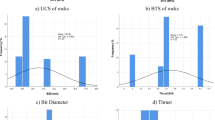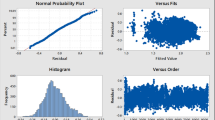Abstract
Drilling forms an important component of a drill and blast cycle consuming a considerable time and resources of an excavation cycle and necessitates scientific selection and performance prediction. Drill penetration rate is influenced by many controllable and uncontrollable parameters such as intact rock, rock mass, bit, machine’s design and operational parameters with varying degree of influence. Often, the predicted versus measured drilling rate has lot of variances thereby affecting drill economics, project time lines and feasibility. Wrong selection of drilling equipment can lead to an increase in development cycle time up to 30 to 40%. Therefore, in this study the challenges faced in selection of a right drill equipment and its associated influential factors are assessed. Selection methodology for a set of working ranges of underground drilling rigs is developed. Performance studies for mechanized drill jumbos operating in Indian and Bhutan underground hard rock environment are conducted. Performance studies for drill jumbos in underground hard rock mines over a period of one year indicated that the machine’s availability is around 80% however its utilization is found to be only about 30% with 76% productivity on an average. The studies indicated that selection of drilling equipment affects tunnelling cycle greatly in civil excavations compared to mine development headings owing to larger scale and volume in former. However, there is a requirement of developing an all-inclusive drillability model which aids in selection of right drill equipment for obtaining a desired rate of drilling in a given geotechnical environment.
Access this chapter
Tax calculation will be finalised at checkout
Purchases are for personal use only
Similar content being viewed by others
References
Alireza C, Hasan KS, Shahriar K, Khademi Hamidi J (2012) An estimation of the penetration rate of rotary drills using the Specific Rock Mass Drillability index. Int J Min Sci Technol 22:187–193. https://doi.org/10.1016/j.ijmst.2011.09.001
Ataei M, KaKaie R, Ghavidel M, Saeidi O (2015) Drilling rate prediction of an open pit mine using the rock mass drillability index. Int J Rock Mech Min Sci 73:130–138. https://doi.org/10.1016/j.ijrmms.2014.08.006
Bhatawdekar RM, Edy MT, Danial JA (2019) Building information model for drilling and blasting for tropically weathered rock. J Mines, Met Fuels 67:494–500
Bhatawdekar RM, Mohamad ET, Singh TN, Armaghani DJ (2019) Drilling and blasting improvement in aggregate quarry at Thailand - a case study. J Mines, Met Fuels 67:357–362
Bilgin N, Yazici S, Eskikaya S (1996) A model to predict the performance of roadheaders and impact hammers in tunnel drivages. In: ISRM international symposium - EUROCK 1996, pp 715–720
Brady B, Brown E (2004) Rock Mechanics for underground mining. Third. Kluwer Academic Publishers
Franca LFP (2011) A bit-rock interaction model for rotary-percussive drilling. Int J Rock Mech Min Sci 48:827–835. https://doi.org/10.1016/j.ijrmms.2011.05.007
Hoseinie HS, Pourrahimian Y, Aghababaei H (2007) Analyzing and physical modeling of joints dipping effects on penetration rate of rotary drilling in open pit mines. In: 20th international mining congress and exhibition of Turkey, IMCET 2007. pp 259–263
Hoseinie SH, Aghababaei H, Pourrahimian Y (2008) Development of a new classification system for assessing of rock mass drillability index (RDi). Int J Rock Mech Min Sci 45:1–10. https://doi.org/10.1016/j.ijrmms.2007.04.001
Jimeno C, Jimeno E, Carcedo F (1995) Drilling and blasting of rocks, Balkema
Kumar S, Murthy V (2012) Drillability prediction and its assessment in coal measure rocks to aid rotary blasthole drill selection - some investigations. In: National seminar on mining equipment: new technologies, challenges & applications (MENTCA). pp 27–38
Oddsson B (1982) Rock quality designation and drilling rate correlated with lithology and degree of alteration in volcanic rocks from the 1979 Surtsey drill hole
Rathinasamy V, Mohamad ET, Komoo I, et al (2020) Influence of physico-mechanical properties of tuff on penetration rate – a case study in southern Johor Bahru, Malaysia. J Mines Met Fuels 68:136–143. https://doi.org/10.18311/jmmf/2020/27644
Sandvik Underground Drill Rigs And Bolters. https://www.rocktechnology.sandvik/en/products/underground-drill-rigs-and-bolters/, Accessed 3 Nov 2021
Sandvik Tamrock Corp. (1999) Rock Excavation Handbook
Siva Prasad BNV, Murthy VMSR (2018) Laboratory investigations into fracture propagation characteristics of rock material. In: AIP conference proceedings, pp 020009–1–7. https://doi.org/10.1063/1.5030313
Siva Prasad BNV, Murthy VMSR (2017) Influence of rock abrasivity and bit wear on drill penetration rate. In: INDOROCK : 7th Indian rock conference, pp 387–395
Siva Prasad BNV, Murthy VMSR, Pandey SK (2016) Investigations on rock drillability applied to underground mine development vis-à-vis drill selection. In: Recent advances in rock engineering (RARE). Atlantis Press, pp 399–403. https://doi.org/10.2991/rare-16.2016.62
Taheri A, Qao Q, Chanda E (2016) Drilling penetration rate estimation using rock drillability characterization index. J Inst Eng Ser D 97:159–170. https://doi.org/10.1007/s40033-015-0104-6
Tanaino A (2005) Rock classification by drillability. Part I: analysis of the available classifications. J Min Sci 41:541–549
Tanaino AS, Lipin AA (2004) State and prospects of the percussive-rotary blasthole drilling in quarries. J Min Sci 40:188–198
Thuro K (1997) Drillability prediction: geological influences in hard rock drill and blast tunnelling. Geol Rundschau 86:426–438. https://doi.org/10.1007/s005310050151
Venkatesh HS, Balachander R, Gopinath G (2018) Drilling and blasting of tunnels in himalayan geology. TAI J (A Half Yrly Tech J Indian Chapter TAI) 2(7):21–28
Zare S, Bruland A (2013) Applications of NTNU/SINTEF drillability indices in hard rock tunneling. Rock Mech Rock Eng 46:179–187. https://doi.org/10.1007/s00603-012-0253-y
Siva Prasad BNV, Murthy Sripad, VMSR, Naik R Influence of static and dynamic rock properties on drillability prognosis for mining and tunnelling projects. Indian Geotech J https://doi.org/10.1007/s40098-022-00608-0
Siva Prasad BNV, Murthy Sripad VMSR, Naik R Drillability predictions in Aravalli and Himalayan rocks – A petro-physico-mechanical approach. Curr Sci 122(08):901–917. https://doi.org/10.18520/cs/v122/i8/907-917
Acknowledgements
The authors are grateful to the Director, NIRM, Mine Management of Hindustan Zinc Limited, India and the Project Authorities of Punatsangchhu-II Hydroelectric Project, Bhutan for allowing the authors to perform the studies. The support extended by the officials of Rock Excavation Laboratory, Department of Mining Engineering, IIT (ISM) is duly acknowledged. This forms the part of PhD work being accomplished by the first author at IIT (ISM) Dhanbad.
Author information
Authors and Affiliations
Corresponding author
Editor information
Editors and Affiliations
Rights and permissions
Copyright information
© 2022 The Author(s), under exclusive license to Springer Nature Singapore Pte Ltd.
About this paper
Cite this paper
Prasad, B.N.V.S., Murthy, V.M.S.R., Naik, S.R. (2022). Challenges in Drill Equipment Selection vis-à-vis Underground Excavations – A Methodology. In: Verma, A.K., et al. Proceedings of Geotechnical Challenges in Mining, Tunneling and Underground Infrastructures. ICGMTU 2021. Lecture Notes in Civil Engineering, vol 228. Springer, Singapore. https://doi.org/10.1007/978-981-16-9770-8_9
Download citation
DOI: https://doi.org/10.1007/978-981-16-9770-8_9
Published:
Publisher Name: Springer, Singapore
Print ISBN: 978-981-16-9769-2
Online ISBN: 978-981-16-9770-8
eBook Packages: EngineeringEngineering (R0)




